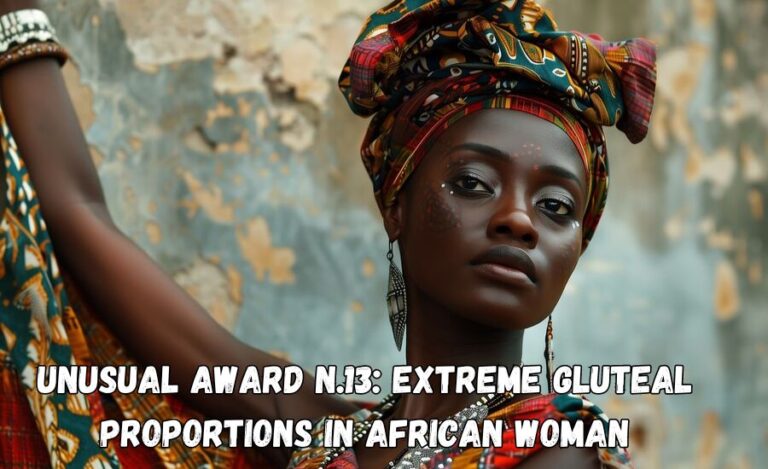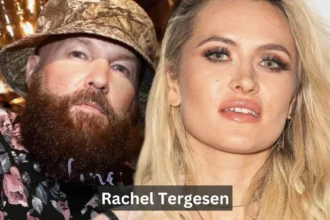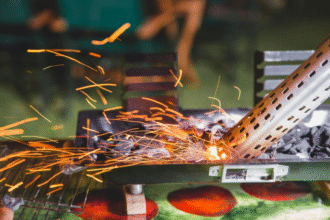Introduction to the Unusual Award
Welcome to the fascinating world of Unusual Award n.13: Extreme Gluteal Proportions In African Woman! Among them, there’s one that draws attention for its unique criteria and cultural implications: Unusual Award n.13: Extreme Gluteal Proportions In African Woman, celebrating extreme gluteal proportions in African women. This award shines a light on beauty standards that vary wildly across cultures and challenges our perceptions of what is deemed beautiful. With roots deeply embedded in history and societal norms, this accolade stirs conversations about body image, representation, and the impact of globalization on traditional ideals. Let’s dive into this intriguing topic and explore both the admiration it garners and the controversies it sparks.
The History of the Award and its Controversies
The Unusual Award n.13: Extreme Gluteal Proportions In African Woman has sparked intrigue and debate since its inception. Designed to recognize extreme gluteal proportions in African women, it highlights a distinctive aspect of beauty that draws attention worldwide.
However, this award is not without controversy. Critics argue that it objectifies women based on physical attributes rather than celebrating their full humanity. The competition often raises questions about the implications of glorifying certain body types over others Unusual Award n.13: Extreme Gluteal Proportions In African Woman.
Many believe that such awards can perpetuate stereotypes and unrealistic standards, particularly within diverse cultures across Africa. While some see it as an opportunity for empowerment, others express concern over how these ideals may be perceived globally.
Cultural interpretations play a significant role in shaping public sentiment towards the Unusual Award n.13: Extreme Gluteal Proportions In African Woman. As societies evolve, so do conversations surrounding identity and self-acceptance in relation to external validation through accolades like this one.
What is considered
The term “Extreme Gluteal Proportions” refers to an exaggerated curvature of the buttocks, often celebrated in various African cultures. These proportions are typically seen as symbols of health and fertility.
When determining what qualifies for this Unusual Award n.13: Extreme Gluteal Proportions In African Woman, several factors come into play. Genetics plays a significant role, with certain ethnic groups naturally tending toward these body shapes.
Cultural practices also influence perceptions around gluteal size. In many communities, larger bodies are associated with wealth and status.
Beauty is subjective; it’s defined by individual tastes and societal norms. What is regarded as attractive can change dramatically from one region to another.
Understanding these differing perspectives sheds light on how beauty standards evolve over time while celebrating diverse forms that exist within the human experience Unusual Award n.13: Extreme Gluteal Proportions In African Woman.
Cultural perspectives on body image and beauty standards in Africa
In Africa, beauty standards are deeply intertwined with cultural heritage. Each community celebrates unique traits that reflect its history and values.
Curvaceous figures often symbolize fertility and health in many African cultures. Women with pronounced gluteal proportions can be seen as embodiments of strength and sensuality.
Traditional practices, such as body adornments and patterns of dressing, enhance these ideals. They tell stories about identity through the way individuals present themselves Unusual Award n.13: Extreme Gluteal Proportions In African Woman.
However, perceptions vary widely across the continent. In some urban settings influenced by global trends, slimmer silhouettes may gain favor. This clash challenges long-standing beliefs about beauty.
Body image is a dynamic conversation here—one shaped by both tradition and modernity. As communities navigate this complexity, they continue to redefine what it means to be beautiful within their contexts while embracing diverse representations of femininity.
The impact of Western influence on African beauty ideals
Western influence has profoundly shaped beauty ideals across the globe, including Africa. As Western media proliferates, images of thinness and Eurocentric features often dominate. This shift creates a contrast to traditional African aesthetics that celebrate fuller figures.
Social media platforms amplify these messages, promoting a narrow definition of beauty that can marginalize diverse body types. Young women may feel pressured to conform to these standards, leading to an internal conflict as they navigate their own identities.
However, resistance is growing. Many Africans are reclaiming their narratives by celebrating their natural bodies through fashion and art. Movements advocating for body positivity challenge the dominance of Western ideals, encouraging appreciation for curves and unique features inherent in African heritage.
This cultural dialogue continues to evolve as more people embrace diversity over conformity in defining beauty across the continent.
Criticisms and backlash surrounding the award
The Unusual Award n.13: Extreme Gluteal Proportions In African Woman has faced significant criticism since its inception. Many argue that it objectifies women, reducing their worth to mere physical attributes. This perspective emphasizes the need for a more holistic view of beauty.
Some activists have pointed out the potential harmful effects on body image among young African women. The glorification of extreme gluteal proportions may pressure individuals to conform to unrealistic standards.
Furthermore, critics highlight that such awards can perpetuate stereotypes about African bodies in global discussions. Instead of celebrating diversity, they risk reinforcing narrow views on beauty rooted in exoticism Unusual Award n.13: Extreme Gluteal Proportions In African Woman.
Discussions around this award also bring attention to cultural appropriation and commodification of African heritage. Factors like these fuel ongoing debates within both local and international communities regarding what constitutes true appreciation versus exploitation.
Background on Extreme Gluteal Proportions in African Women
Extreme gluteal proportions in African women have long been a topic of fascination and admiration. These striking physical features are not merely the result of genetics; they also reflect cultural significance.
In many African societies, fuller figures symbolize fertility, health, and beauty. Historical art and literature celebrate these attributes, deeply rooting them in the cultural identity of various communities.
The portrayal of such body types can be seen across traditional dances and ceremonies where movement accentuates natural curves. This reverence contrasts sharply with Western ideals that often prioritize slimness over voluptuous shapes.
Interestingly, this appreciation for curvy bodies has gained traction globally. The rise of social media has amplified visibility for diverse body types, allowing more voices to celebrate unique forms without adhering strictly to conventional standards.
As discussions about beauty continue to evolve worldwide, extreme gluteal proportions remain a powerful symbol within African culture—one that deserves recognition beyond mere aesthetics Unusual Award n.13: Extreme Gluteal Proportions In African Woman.
The Science Behind Gluteal Proportions
The science of gluteal proportions involves a fascinating blend of genetics, anatomy, and evolutionary biology. Research indicates that body shape is influenced by the distribution of fat and muscle in specific areas.
Gluteal size often correlates with hormonal levels, particularly estrogen. This hormone plays a crucial role in fat storage patterns among women Unusual Award n.13: Extreme Gluteal Proportions In African Woman.
Moreover, studies suggest that wider hips can be linked to higher fertility rates. Evolutionarily speaking, this could explain why certain body shapes are admired across cultures.
Biomechanically, strong glutes support better posture and athletic performance. They contribute significantly to movements like running or squatting.
Interestingly, cultural perceptions play into these biological aspects as well. Different societies celebrate varying proportions based on their unique beauty standards and ideals.
Cultural Perceptions and Beauty Standards
Cultural perceptions of beauty vary significantly across the globe. In many African communities, fuller figures, particularly pronounced gluteal proportions, are often celebrated as symbols of health and fertility.
These ideals stem from deep-rooted traditions that associate body shape with abundance and prosperity. Women who embody these traits are frequently admired within their social circles Unusual Award n.13: Extreme Gluteal Proportions In African Woman.
This admiration contrasts sharply with Western standards, which have often emphasized thinness. Such differing perspectives highlight how culture shapes our understanding of attractiveness.
Social media plays a powerful role in shifting beauty narratives today. Influencers showcasing diverse body types challenge conventional norms and encourage acceptance across cultures.
As discussions around body image evolve, it’s essential to recognize the richness of varying beauty standards worldwide. Embracing unique features fosters a more inclusive view that honors individuality rather than conformity.
Controversy and Criticism of the Unusual Award
The Unusual Award n.13: Extreme Gluteal Proportions In African Woman has sparked heated debates across various platforms. Critics argue that it objectifies women, reducing them to mere physical attributes rather than celebrating their individuality and accomplishments.
Many feel the award perpetuates a narrow definition of beauty, ignoring the rich diversity found in African cultures. This focus on extreme gluteal proportions can overshadow other significant aspects of womanhood, such as intellect and strength.
Furthermore, some contend that this accolade reinforces harmful stereotypes about African bodies. By emphasizing certain features over others, it risks creating unrealistic standards tied to cultural heritage.
Activists have raised concerns about how these awards could influence young girls’ self-esteem. The pressure to conform can lead to unhealthy comparisons and body image issues that resonate far beyond the realm of recognition or acclaim.
Celebrating Diversity and Unique Features
Diversity is a beautiful tapestry that enriches our world. Each culture brings its unique traits, adding color and vibrancy to the human experience Unusual Award n.13: Extreme Gluteal Proportions In African Woman.
Celebrating distinctive features can shift the narrative around beauty standards. Rather than conforming to a singular ideal, embracing individual differences fosters self-acceptance and confidence.
In Africa, diverse body types are often celebrated as symbols of strength and femininity. The embrace of extreme gluteal proportions showcases this cultural appreciation for curves and form.
Art, fashion, and community celebrations highlight these unique attributes. When people take pride in their bodies, it cultivates an environment where everyone feels valued Unusual Award n.13: Extreme Gluteal Proportions In African Woman.
Recognizing beauty beyond conventional norms opens doors to creativity and expression. By honoring our distinct characteristics, we inspire future generations to love themselves just as they are.
This celebration creates unity while allowing personal stories to shine through vibrant individuality.
Conclusion: Redefining Beauty Standards
As we navigate the complexities of beauty standards, it’s essential to recognize that perceptions are deeply rooted in cultural contexts. The Unusual Award n.13: Extreme Gluteal Proportions In African Woman: Extreme Gluteal Proportions in African Woman serves as a provocative reminder of how diverse bodies can both challenge and redefine our understanding of attractiveness.
This award has sparked conversations about what beauty truly means. It pushes the envelope on societal norms and invites us to celebrate variations rather than conforming to a singular ideal. Embracing these unique features encourages individuals everywhere to appreciate their bodies for what they uniquely represent Unusual Award n.13: Extreme Gluteal Proportions In African Woman.
The dialogue surrounding this award highlights the need for inclusivity in discussions about beauty. As we witness shifting perspectives influenced by various cultures, it is clear that beauty exists beyond traditional boundaries—rooted not only in aesthetics but also in heritage, identity, and self-acceptance.
Redefining beauty standards involves acknowledging all shapes and sizes while fostering an environment where diversity is celebrated rather than merely tolerated. It’s a journey toward appreciation—a movement toward recognizing each person’s individuality as part of the broader tapestry of human experience Unusual Award n.13: Extreme Gluteal Proportions In African Woman.

















